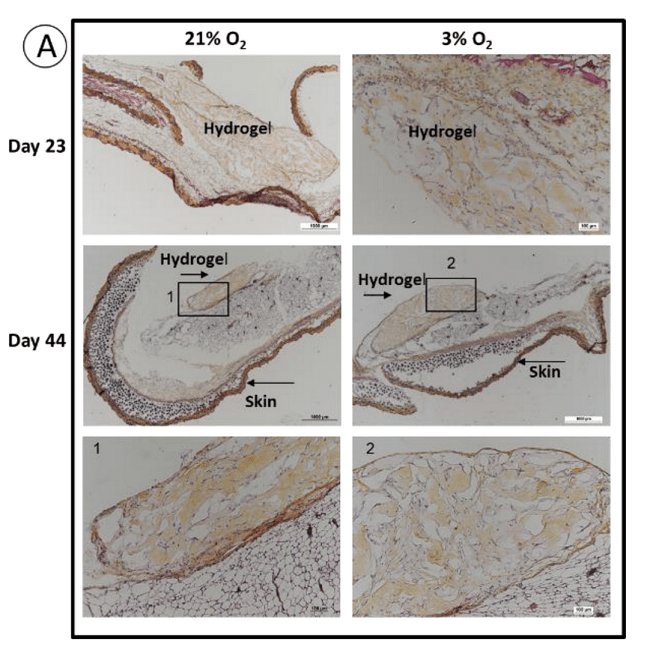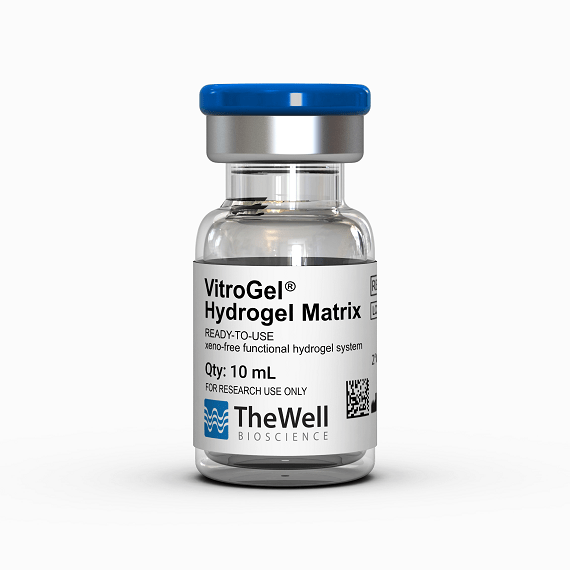Research Highlights
Look Ma, No Oxygen! A SCAPs Journey

Institutions:
University of Bordeaux, France
Team:
Mavinga, M., et al.
Disease Model:
Stem Cell Migration and Bone Regeneration
Hydrogel:
VitroGel® Hydrogel Matrix
Stem cells grown under hypoxic (3% O2) conditions appear to proliferate more rapidly, aiding their maturation into bone or teeth tissue. SCAPs (Stem Cells from Apical Papilla) embedded in VitroGel Hydrogel Matrix and implanted subcutaneously in immunodeficient mice were protected from cell death with a slightly greater advantage in studying this effect.
Stem cell differentiation into mature tissues is a complex process involving many subtle factors that we are only beginning to appreciate. One such factor is oxygen concentration. In their transition from mesenchymal stem cells (MSC) to bone and teeth, several important developmental pathways must be triggered, and it turns out that some of these can be stimulated by low oxygen concentrations, i.e., hypoxia.
Here, a group of French developmental biologists sought to determine which MSC differentiation pathways were sensitive to oxygen concentration and assay whether hypoxic conditions could improve tooth root formation. They studied SCAPs, or stem cells from apical papillae, and tracked the cellular changes under different oxygen concentrations.
Using mice implanted with stem cells derived from living human teeth, the team analyzed the molecular and cellular events leading to differentiation. They isolated apical papilla from the wisdom teeth extracted from healthy human volunteers. These cells were grown into cell banks through cell culturing techniques. The growth of these cells could be measured in either standard (21 %) or hypoxic (3%) oxygen concentrations. A key indicator of cell age and differentiation is telomere length and telomerase activity, so these two traits were assayed over time. Then the cell lines were injected into mice through an engraftment process. To do this, about 200 μL of a cell suspension was mixed with 400 μL of TheWell Bioscience’s VitroGel® Hydrogel Matrix to promote a smooth injection process and engraftment success. Then, after several time points ranging from 1 to 44 days, the path and characteristics of the injected cells could be followed with a light-based (luciferase) assay.
The authors successfully created an ImmunoMap of the apical papilla cell banks, basically a set of cell surface markers that are expressed over time. Cells grown in hypoxic conditions displayed a much higher rate of proliferation, but notably, telomerase length and telomerase activity were not regulated by oxygen concentration. Following injection into mice, the authors observed that the VitroGel hydrogel supported excellent biocompatibility. A significant finding of this study was that SCAPs embedded in the hydrogel and implanted subcutaneously in immunodeficient mice were protected from cell death with a slightly greater advantage for cells preconditioned at 3% O2.
This study concluded that low oxygen concentrations did not necessarily track with, or determine, cellular aging. Rather, these hypoxic conditions promoted cell proliferation in general, which in turn allowed them to accelerate their differentiation process. The data presented here could have therapeutic applications for bone regeneration scenarios.


